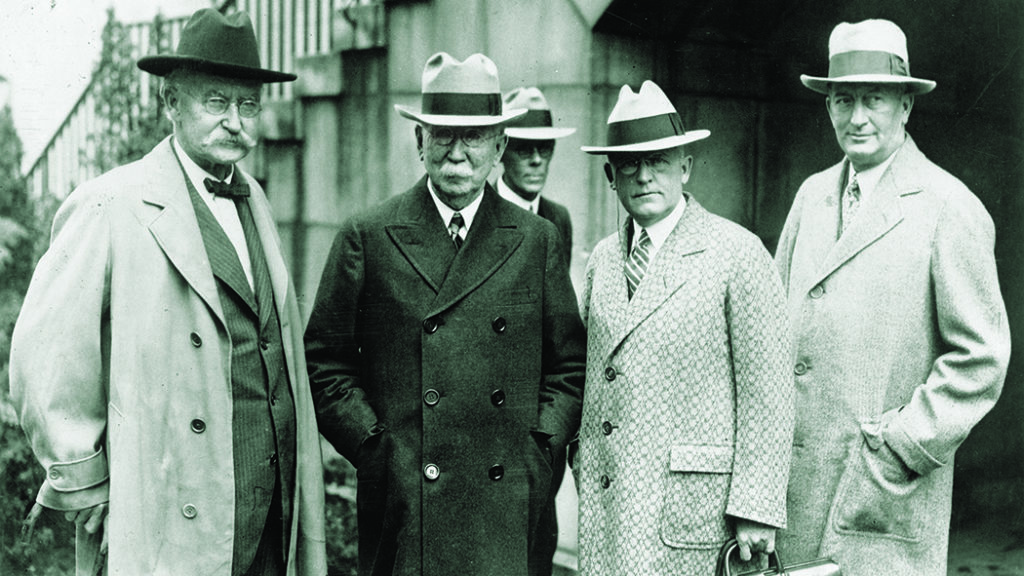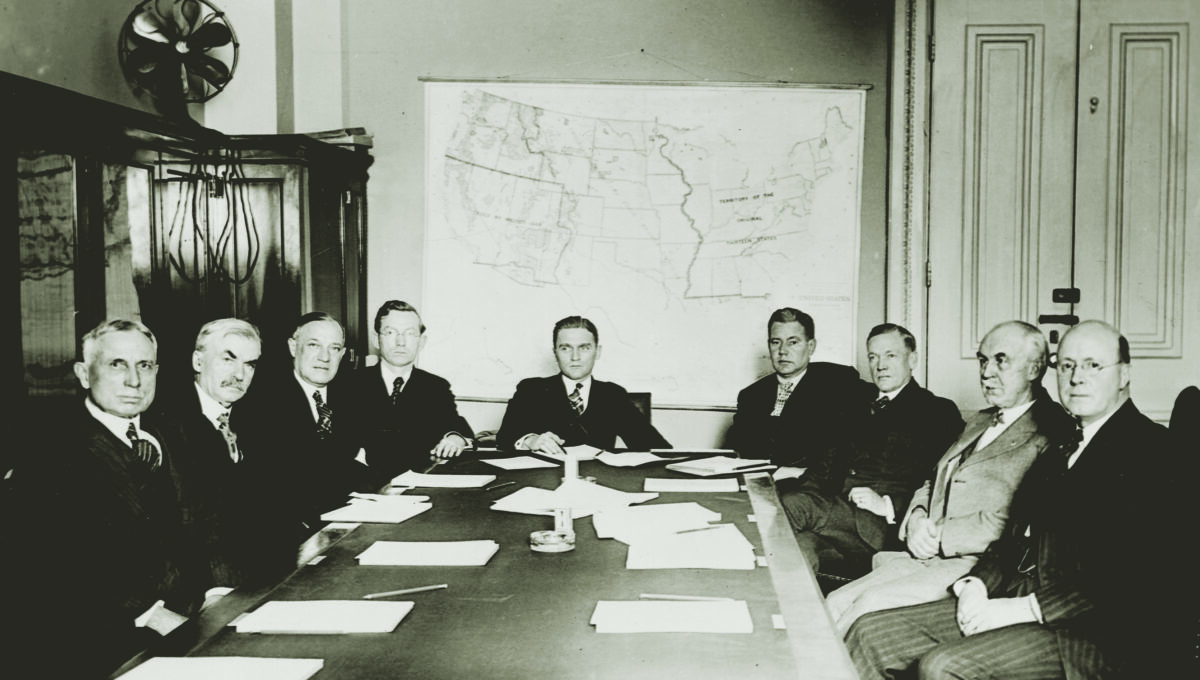Scandals have dotted American politics from the start. In 1798, Representative Matthew Lyon (Democratic-Republican-Vermont) was censured for spitting on a colleague, convicted of violating the Alien & Sedition Act, and reelected—from prison. But save for Watergate, font of America’s sole presidential resignation, no scandal outranks the Teapot Dome Affair, an outrage that effloresced under President Warren G. Harding. Teapot Dome also stands alone in its impact on government operations, since it established the constitutional basis for Congress to investigate how Cabinet members and subordinates implement executive branch functions assigned the President—a precedent with current-day implications.
Corruption riddled Harding’s presidency, but other misdeeds paled beside the fate of two federal oil holdings reserved for Navy use. Interior Secretary Albert B. Fall got Harding to transfer the reserves—Teapot Dome in Wyoming and Elk Hills in California—to his department. In crooked private deals Fall leased the reserves to companies that lubricated the process with $400,000 (today, $5.6 million) in bribes. Officials involved did not pretend to be serving the public. “People in the government were selling the administration to the highest bidder,” historian Robert Dallek wrote. “They weren’t interested in the national interest; they were interested in their self-interest.” Royalties paid the public coffers were paltry. Fall’s style of living suddenly grew opulent.

An oilman irked that the leases had not been put up for bid griped, triggering a 1922 Senate Public Lands Committee inquiry that exposed Fall’s bribes. After Harding died, the committee told successor Calvin Coolidge to name a special counsel to turn the congressional findings into legal action. Courts canceled the oil leases. In 1929 Fall became the first Cabinet member to do time for misconduct in office.
Congress wondered how Fall had avoided alarming the Justice Department. Despite blatantly violative behavior and Fall’s wallow in filched lucre, Justice had snoozed. The Senate named a five-man panel to examine why. Curiosity fell on U.S. Attorney General Harry M. Daugherty who, as a small-town Ohio attorney, had conceived the gambit that finagled Harding the 1920 Republican nomination when the front-runners deadlocked. A grateful Harding made Daugherty the nation’s top prosecutor.
By this time congressional probes of executive branch actions had become embedded. The first came during the second Congress, in 1792, when the House of Representatives set up a special committee to discover why, the year before, American troops commanded by General Arthur St. Clair had lost so badly to 1,000 Indians in the Battle of the Wabash River 100 miles north of Cincinnati, Ohio.
Investigations became so standard that, though the Constitution gives lawmakers no specific investigative authority, their power to do so seldom was challenged. Investigating seemed to be inherent to legislating. After all, five House members in 1792 had been among those drafting the Constitution, and all five voted for the St. Clair inquiry. The outcomes of the few cases touching on the issue and reaching the Supreme Court suggested congressional investigations were allowed but did not address the question directly. The main such ruling, 1881’s Kilbourn v. Thompson, invalidated a congressional inquiry into how assets of a bankrupt real estate scheme had been distributed among creditors, including the United States. The justices noted that Congress had given no valid legislative aim for its scrutiny. Kilbourn established a test for investigative legitimacy: an inquiry must not only deal with “subjects on which Congress could validly legislate” but the resolution authorizing that inquiry must specify the lawmakers’ interest in considering such legislation.
Fast forward to Teapot Dome. Congress in its resolution setting up the investigation into the Justice Department gave no legislative purpose. That offered an opening for a reluctant witness to challenge a subpoena to appear at the hearings and to impugn the whole process as unconstitutional. The case also gave the Supreme Court a shot at a definitive ruling on the legitimacy of congressional inquiries.
Reluctant witness Mally S. Daugherty, president of Midland National Bank in the attorney general’s hometown, was the AG’s older brother. The Senate ordered Daugherty the banker to appear in person bearing records on safety deposit vault rentals and customer accounts showing large cumulative withdrawals. Daugherty refused. The Senate authorized his arrest and forced appearance.
Deputy Senate Sergeant at Arms John J. McGrain arrested Mal Daugherty. The banker immediately went to the nearest federal court, claiming the inquiry was unconstitutional and demanding his release. The court agreed, finding that the investigation lacked a stated legislative goal and that the Senate was in essence trying the attorney general—a judicial function, not a legislative function.
By the time the Supreme Court ruled in January 1927, much had changed. Coolidge had succeeded Harding. Secretary of State Charles Evans Hughes and Secretary of Commerce Herbert Hoover had persuaded the new president to force Harry Daugherty out. Columbia University Law School dean Harlan Fiske Stone briefly headed Justice before being named to the Supreme Court. Stone recused himself from Mal Daugherty’s case, but his eight colleagues had no trouble finding the lower court wrong and awarding Congress broad discretion to begin an inquiry, to decide what to investigate, and to compel witnesses to testify and produce subpoenaed documents. The core issue in McGrain v. Daugherty was how the Department of Justice was run. “Plainly the subject was one on which legislation could be had and would be materially aided by the information which the investigation was calculated to elicit,” Justice Willis Van Devanter wrote in the unanimous decision.
Van Devanter then went beyond the immediate issue of whether Harry Daugherty had been derelict as U.S. attorney general, decreeing that lawmakers have extensive investigatory power. Van Devanter supported that conclusion by pointing to the long history of congressional investigations and to similar state legislature probes upheld by courts in Massachusetts, New York, West Virginia, Wisconsin, and Missouri.
In a decision The New York Times called “one of the most sweeping ever handed down,” Van Devanter wrote, “A legislative body cannot legislate wisely or effectively in the absence of information respecting the conditions which the legislation is intended to affect….We are of the opinion that the power of inquiry—with process to enforce it—is an essential and appropriate auxiliary to the legislative function.” Harry Daugherty eventually was cleared by the Senate committee, which decided it had not found evidence that Daugherty knew of the oil lease scheme.
Congressional inquiries had been common, but McGrain removed any legal threat to them. The day after the decision was handed down, the Senate began action to force a reluctant witness, utilities magnate Samuel Insull, to testify in an inquiry into nearly $1 million in suspicious donations to senatorial candidates in Illinois. That impact has persisted.
“McGrain’s rationale and theory has been picked up and cited extensively,” says lawyer Todd Tatleman, the Congressional Research Service expert on the issue.
For instance, the justices cited McGrain in upholding congressional demands for testimony in probes of domestic Communist Party activities and of anti-Vietnam War activities.
Perhaps because McGrain validated existing practices rather than changing practice, it appears on no list of the Court’s most significant decisions, and for most of its existence has been known primarily to lawyers specializing in issues involving separation of powers. That obscurity is gone. All year the case has been invoked repeatedly as politicians and journalists have commented on House and Senate probes of the Trump administration.
This SCOTUS 101 column appeared in the December 2019 issue of American History.





